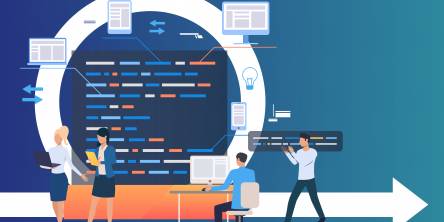Why Software Testing Strategy Must Transform in 2021?
The intricacy of software programs has increased significantly as a result of a rise in the number of delivery connections, launched, functions, features, networks, and embedding technologies available to developers. Businesses now, more than anything, have their work cut outside for them: they must create high-quality apps while also expediting their time to market. The software testing approach must be transformed to keep up with new advancements such as DevOps and Agile, which have results that are centered on Continuous Integration and Delivery. This has enhanced more crucial for firms to endure aggressively and meet consumer predications.
In this article, we'll explore the reasons why the company's software testing approach must be revised in 2021.
1. The expanding reach of the Internet of Things: You must have noticed a rise in the level of automation in consumer durables such as televisions, air conditioners, geysers, and so on. For instance, the brightness of your television set's display may be adjusted depending on the amount of led lamp present. In addition, if the temperature of the water exceeds a certain level, the geyser will shut off automatically. The existence of enterprise devices in these gadgets has made it feasible to enjoy these kinds of experiences.
As a result, only if the quality of such electronic hardware is maintained at an exceptionally high level, the operation of these devices will be significantly impaired. So the software testing approach should not only test the application(s) separately, and therefore should test the application(s) as if it were a component of the device. Considering how quickly the Internet of Things is spreading across the world, software application screening must be thorough to ensure that every feature and API is meeting its intended goals. It recommends that a software testing method be used to verify the program's accessibility, interoperability, scalability, dependability, safety, efficiency, and data quality, among other characteristics.
2. The introduction of artificial intelligence and machine learning technology: The year 2021 will witness the expansion of AI and machine learning technology into additional areas. Furthermore, artificial intelligence (AI) would be used in software application testing to address the problems of increasing complexity, repetitive activities, and shortening the time to market, among other things. These will vastly improve the skills of human testers while freeing them from boring, monotonous, or mission-critical jobs, which they will be able to devote their time to. In turn, this will lead to resource optimization and the achievement of tight turnaround requirements.
3. Big data testing: A large number of software programs, each with a diverse set of APIs, produce a massive quantity of data. For example, the software is used to purchase airline or railroad tickets, among other things. In this case, a large amount of data must be verified using criteria such as direct relation tests. In addition to the program, the data should be checked for correctness, completeness, security, coherence, authenticity, and relevance, among other characteristics.
4. Shift from conventional performance testing to performance engineering: Because the quality of software programs is defined by the number of digital touchpoints and APIs that they have, conventional performance testing must be replaced with end up making. This means that performance measures such as load, test, spike, scalability, endurance, and volume will no longer be used in the software testing methodology to determine how well a piece of software performs.
A performance engineering approach would involve investigating how different components of a system work together to provide high-quality results seamlessly. The components would cover the full gamut of business and software issues, including privacy, scalability, effectiveness, hardware, operations, return on investment, and customer satisfaction, among others.
5. The shift from quality assurance to quality engineering: The old quality assurance approach no longer works in the new world order. As Agile and DevOps became an illegitimate industry standard, the emphasis is shifting to ensuring seamless integration and testing across the software development lifecycle (SDLC) and beyond.
Quality engineering must be engaged to foolproof a system against intrinsic faults across the whole researchers and research operations, which must be accomplished via the use of test automation.
6. Challenges of test automation: As software rate increases, and in response to expectations such as providing quicker testing cycles, detecting bugs early, and guaranteeing a higher classification accuracy, test automation is becoming more popular. This allows the team to concentrate on activities such as the preparation of automated software testing cases, the simulation of variables, and the analysis of test results. Considering that testing will be performed for both functional and non-functional elements, automation testing is the most appropriate method.
7. Application security: Even though virtual reality makes our everyday activities more comfortable, quick, speedy, and malfunction, the threat of a security breach looms big in the background. As security keeps on filling in significance as an issue for analyzers and engineers in 2021 and for years to come, the DevOps testing system ought to incorporate security as a feature of the DevOps way to deal with testing.
Conclusion
For companies to provide bug-free apps while also ensuring greater test coverage and a quicker time to market, software testing has been a need. Businesses will use new testing methods to remain ahead of the competitors and provide a positive consumer experience in 2021.
Similar Articles
Unless you have been hiding in a cave somewhere, you would know and realize that the world is creating information at a stunning speed. While it is genuinely considered normal information that said data can now be turned into the groundwork of achievement for essentially any business in the present day and age.
Software development refers to the procedure of constituting and nourishing software applications. This provokes the utilization of many fundamentals and practices. Software development targets constitute structured, dependable, and beneficial software.
Designing a data warehouse is a strategic activity that builds the groundwork for strong data management and analytics capabilities within a business. In today's data-driven world, the systematic creation of a data warehouse is not only a technical requirement but also a critical step in harnessing the power of information for informed decision-making.
The integration of Internet of Things (IoT) technology into the construction and real estate sectors, which include buildings, infrastructure, homes, and businesses, is predicted to increase dramatically in the future. Despite this predicted expansion, the construction industry is behind other industries in terms of IoT adoption.
In this dynamic world of innovative and transformative technology, the use of Minimum Viable Product (MVP) has proven to be a winning strategy for success.
While monolithic applications may have waned in popularity during the era dominated by the cloud and microservices, interest is resurgent. Organizations, in considering their position on the application modularity spectrum, are now examining both the advantages and drawbacks of relying on microservices.
Data visualization is an indispensable tool that allows us to transform raw, and often unstructured data into insightful visuals, identify patterns, and communicate these insights to the wider audience and stakeholders.
For modern businesses to thrive, ensuring the effective management of inventory stands has become vitally important. Inventory management stands as a cornerstone of success. And the emergence of the Internet of Things (IoT) has introduced a new era of connectivity and efficiency across diverse industries.
Do you know what the following e-commerce companies have in common: Amazon, Walmart, eBay, and more? All of these e-commerce companies' apps make use of Java. Java is decidedly among the leading choices of programming language for e-commerce applications because it offers a world of benefits; for example, since Java code can be run on any platform with a Java Virtual Machine (JVM), users of e-commerce apps made with Java can access the said apps on a variety of devices.








